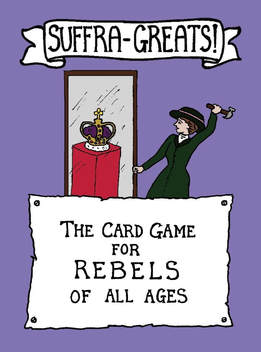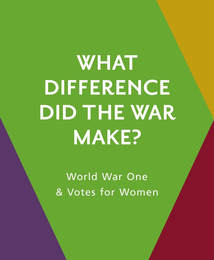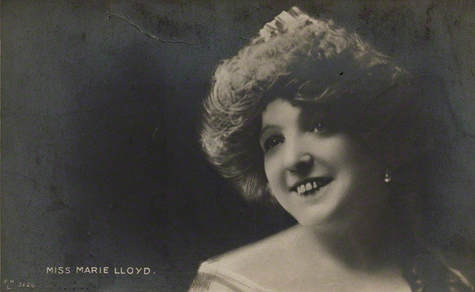|
In the first few months of 2012 I worked as a dresser on South Downs/The Browning Version at the Comedy Theatre in London. I was in the second year of my PhD, and also putting together the manuscript of The Methuen Drama Book of Suffrage Plays. Working in wardrobe on West End shows is intense - you're in eight shows a week and often also more for laundry calls, understudy runs, and maintenance sessions. It's also great fun - I've worked in wardrobe on nearly 30 West End shows since 1998 and been fortunate to work with and for some incredibly lovely and talented people on stage and off.
It was on that show that the idea of a suffrage themed 'top trumps' style game first came to me. I thought it would be a great way to introduce some of the amazing campaigners I was finding in my research - and talking about constantly! - to new audiences in an accessible and fun way. My friend Greg who was then the deputy head of the wardrobe dept and is now a tailor was super encouraging of the idea and I mocked up a set to see if it would work. It did. Since that day I've been going on and on about this idea, keen to make it happen but not knowing how to do so. But finally - in 2018 it has! It was totally worth the wait. Suffra-Greats! is a reality.
2 Comments
It's been a couple of months now since my job at Parliament finished - and I've been meaning to write about some of the creative outputs of my time as part of the Vote 100 team. I was part of an AHRC funded project called 'What Difference Did the War Make? World War One and Votes for Women' run by the University of Lincoln and UK Parliament Vote 100 alongside the University of Plymouth. The project outputs included three panel events in Lincoln, Plymouth and London discussing not only the project topic but the work and legacy of past and present female Members of Parliament, alongside workshops for young people, and an exhibition in Parliament and online. You can see that exhibition here: www.parliament.uk
I'm not going to talk about those outputs in this blog post though. Instead this is a brief introduction to some of the other outputs involving project research that happened over the course of my year there - outputs I'm really excited about and that reached out to different audiences in different spaces. There's music, games, theatre, and sweets! My Time Traveller piece broadcast on BBC Radio 3's Essential Classics on Thursday 8th February 2018, was entitled 'Suffragettes on the Run' - and you can listen to it here (it's 1hr and 12 minutes into the programme) Music Hall star and Actresses' Franchise League member Marie Lloyd, no stranger to campaigning for the rights of performers within the theatrical profession, lent her support to suffrage societies by singing at the WFL’s Old World Fair at Caxton Hall in 1909 as part of a series of concerts to raise funds, and appearing in How The Vote Was Won in the same year, presumably as the character of Maudie Spark, the music hall comedienne. As an influential, wealthy and famous performer, she was able to support the sisterhood of suffragists in unique ways. One such gesture involved her allowing her theatrical hamper to be used to smuggle a militant speaker into a meeting at the London Pavilion in 1913. Marked ‘Marie Lloyd, Pavilion. Luggage in advance,’ the hamper contained the WSPU speaker Annie Kenney, who was out of prison on licence after a period of hunger-striking and subject to immediate re-arrest under the ‘Cat and Mouse’ Act if she appeared in public. Kenney wrote about the incident in her autobiography, Memories of a Militant, recalling the workmen who unknowingly delivered her to the theatre in the hamper making ‘growls…about the weight, about actresses having no consideration for the poor men who had to carry their baggage, and so on. I was turned, toppled, banged, dropped, before one of them got me (in my hamper, of course) on to his back.’ The ruse worked, and despite the police officers stationed around the entrances to the theatre, Kenney made it inside unnoticed. The London Pavilion was a regular site for WSPU meetings in 1913, and the building that housed the theatre is still a prominent part of Piccadilly Circus. I remember it housing waxworks music show 'Rock Circus' when I was a child and it most recently was the site of Ripley's Believe it or Not. Built in 1885, it functioned as a music hall and variety venue until 1912, when it became the home of a string of musicals. as well as mixed bills. You can see a London Pavilion programme from 1913 here - and on the bill is a performance by Graham Moffat's company of Scottish Players. Moffat was a suffragist and the author of suffrage play 'The Maid and the Magistrate', published by the AFL. His wife, actress Maggie Moffat, was the second Scottish suffragist to be imprisoned for campaigning, when she was arrested in 1907. The Glasgow WSPU delegate for the Women's Parliament in Caxton Hall, Maggie Moffat was one of fifty-three women arrested when mounted police broke up a group of women marching peacefully to the House of Commons with a resolution for the Prime Minister. She was subsequently imprisoned in the second division in Holloway.
But back to the story in question! Seen the Suffragette film and interested in finding out a bit more about the stories it tells? Well, hello! 1. Police Surveillance PhotosIn the Suffragette film, we see police taking and collating surveillance pictures of suspected militant women both out in public and whilst they are in prison. As violent direct action became more frequent, surveillance of militant women and their networks by police increased. The photographs could then be circulated not only to police forces up and down the country but also to potential sites of protest, like galleries, so that known militants could be refused access.
The women in the pictures below include Mary Richardson (no. 11) who slashed the Rokeby Venus in the National Gallery in 1914 in protest at the treatment of Emmeline Pankhurst in prison, and Kitty Marion (no. 13) a music hall performer and member of the Actresses' Franchise League. It's curious that Marion's publicity photograph has been used here - there are other pictures of her taken by press and police photographers that could have been used but perhaps this full face image was thought more valuable. This little duologue, by 'A. L. Little' appears in the 9th May 1913 edition of newspaper of the Women's Freedom League, the Vote. "Uncle McKenna" is supposed to be the the Liberal MP Reginald McKenna, who was the Home Secretary from 1911-1915. The duologue refers to the Prisoners (Temporary Discharge for Ill Health) Act of 1913, a piece of hotly contested legislation popularly known as the "Cat and Mouse Act" which allowed suffragette hunger-strikers to be forcibly fed to the point of near death, then released on license to recuperate and imprisoned again to continue their sentence as soon as they were well enough... and when they were back in prison they went on hunger-strike and were forcibly fed to the point of near death at which point they were released on license to recuperate and imprisoned again to continue their sentence as soon as they were well enough... [repeat] You can read about it online here and the debates in the House of Commons are available to read on Hansard. Interesting that the "cat" in this duologue is female rather than male... does that make it seem more or less cruel? The Story |
NaomiThoughts, reflections, bits of research Archives
April 2023
Categories
All
|



 RSS Feed
RSS Feed